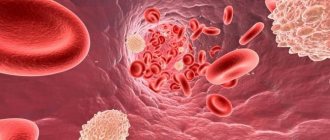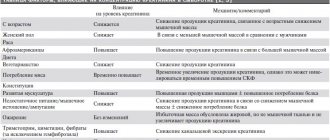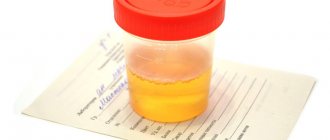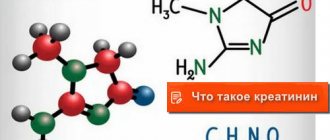Detailed description of the study
A large number of different substances that enter the body every day with food or medicine are metabolized in the liver or kidneys. Blood passing through the kidneys is filtered, as a result of which the “needed” compounds are absorbed back, and the “unnecessary” ones are excreted in the urine. One of these “unnecessary” substances is creatinine.
Creatinine is formed in muscles after the breakdown of creatine phosphate, a high-energy compound in muscle tissue. It is contained in the body in a more or less stable amount, which depends on the volume of a person’s muscles. Creatinine is not deposited in the kidney tubules and is normally completely excreted in the urine. Determining clearance - purification of the blood from any substance - endogenous creatinine makes it possible to assess the activity of glomerular filtration. Thus, with a reduced level of creatinine in the urine and its simultaneous increase in the blood, one can assume a decrease in its filtration in the kidneys.
Several laboratory parameters are required to assess glomerular filtration:
- The volume of blood plasma that passes through the kidney filter in one minute;
- Volume of urine excreted in one minute;
- Blood creatinine concentration;
- Urine creatinine concentration;
- Time during which urine was collected (in minutes).
During the Rehberg test, using these data, the clearance of endogenous creatinine is determined. In other words, the rate at which creatinine is released from the body by the kidneys in one minute.
To correctly assess glomerular filtration, it is necessary to determine not only the creatinine content in the urine, but also in the bloodstream. If the indicators differ greatly, they speak of a malfunction of the kidneys - the filters do not cope with their functions. At the end of the urine collection period, the patient should undergo a blood test for creatinine levels.
If the glomerular filtration level is low, the specialist will prescribe several additional tests and tests to determine the cause of the problem. Among the most common factors leading to this pathological condition are, for example, diabetes mellitus and hypertension. If they are absent, further examination of the body is required.
Periodic performance of the Rehberg test allows the doctor to observe the dynamics of kidney function and, if necessary, adjust treatment.
In what situations is the Rehberg test prescribed to a patient?
If a patient has pain in the kidney area, swelling around the eyes and ankles, hypertension, low urine output or problems with urination, dark urine, blood in the urine, Alport syndrome, amyloidosis, chronic renal failure, Cushing's syndrome, dermatomyositis, diabetes diabetes, intoxication with cardiac glycosides, generalized attacks of tonic-clonic seizures, Goodpasture's syndrome, hemolytic uremic syndrome, hepatorenal syndrome, interstitial nephritis, lupus nephritis, malignant arterial hypertension, membranoproliferative glomerulonephritis, thrombocytopenic purpura, Wilms tumor, factors affecting kidney function, Rehberg test is prescribed.
Normal tubular reabsorption rates start at 95 percent and above. If the level decreases to 90 percent, then this indicates pathological processes occurring in the kidneys. This situation can occur when consuming large amounts of fluid or diuretics - medications with a diuretic effect. Glomerular filtration rate is reduced in patients with acute or chronic nephritis, kidney damage caused by persistent hypertension or diabetes mellitus.
Kidney failure and an increase in nitrogenous waste in the blood can be a consequence of a decrease in glomerular filtration to approximately 80-85 percent. In chronic pyelonephritis, glomerular filtration decreases slowly; in cases of impaired renal concentration ability, this occurs faster.
If, according to the results of the Reberg test, glomerular filtration has decreased to 40 ml per minute, then we can talk about a diagnosis of chronic renal failure.
References
- Post, T., Rose, B. Assessment of renal function: plasma creatinine; BUN; and G.F.R. In UpTo Date 9.1. Edited by BD Rose, 2001.
- Kasiske, B., Keane, W. Laboratory assessment of renal disease: clearance, urinalysis, and renal biopsy. In The Kidney. Sixth edition. Edited by BM Brenner. Philadelphia, WB Saunders Company, 2000. - P. 1129-1170.
- Landry, D., Bazari, H. Approach to the patient with renal disease. In: Goldman L, Schafer AI, eds. Cecil Medicine. 24th ed. Philadelphia, Pa: Saunders Elsevier; 2011. - Ch. 116.
- Pagana, K., Pagana, T. Mosby's Manual of Diagnostic and Laboratory Tests, 4th ed. St. Louis: MosbyElsevier, 2010.
How to prepare for the analysis?
A week before the Rehberg test, it is advisable for the patient to refrain from any physical activity. You should also exclude coffee, strong tea, alcoholic beverages and any types of meat from your diet.
It is necessary to pay attention to medications that were taken previously and inform your doctor about this. Drugs such as corticotropin, cortisol, thyroxine, methylprednisolone, furosemide and other drugs included in similar groups of pharmacological action can significantly affect the filtration rate. Therefore, be sure to list to your doctor everything that you are taking now or have taken over the past 14 days.
Rules for sputum collection
Sputum must be collected in a container (container) in the morning before meals. You should first brush your teeth and rinse your mouth and throat with boiled water to prevent the ingress of food debris and oral microflora. Only sputum produced during a coughing attack should be collected, not expectoration.
Sputum culture
Morning sputum produced during a coughing attack is collected in a sterile, disposable 60 ml container. Before coughing, the patient brushes his teeth with a brush without toothpaste and rinses his mouth with boiled water in order to mechanically remove food debris, desquamated epithelium and oral microflora. Collect the sputum in a sterile container and transport it to the laboratory.
Test for atypical cells (Cytology)
The morning portion of sputum obtained before meals, after rinsing the mouth with water and deep coughing, is collected in a sterile disposable 60 ml container. In order to prevent the destruction of pathological cells, 70% alcohol is added to the material as a stabilizer, proportion 1:2 (1 part alcohol and 2 parts sputum). The time from receipt of the material to its preservation is no more than 2 hours.
SALIVA (PCR method)
- Before collecting saliva, you should rinse your mouth three times with saline solution.
- Saliva should be collected in an amount of at least 5.0 ml in a sterile, disposable 60 ml container.
- After receiving the saliva, screw the lid of the container tightly and label it in accordance with the direction form.
- Do not allow the material to dry out!
Normal values
according to the independent laboratory Invitro:
Creatinine in blood
| Patient age | Men | Women |
| 0 – 12 months | 65 – 100 | 65 – 100 |
| 1 – 30 years | 88 – 146 | 81 – 134 |
| 30 – 40 years | 82 – 140 | 75 – 128 |
| 40 – 50 years | 75 – 133 | 69 – 122 |
| 50 – 60 years | 68 – 126 | 64 – 116 |
| 60 – 70 years | 61 – 120 | 58 – 110 |
| Over 70 years old | 55 – 113 | 52 – 105 |
units of measurement - ml/min/1.7m2.
Note: Total renal tubular reabsorption should be in the order of 95-99%.
Clearance of endogenous creatinine
- On average, in a healthy adult, clearance is about 125 ml (the volume of blood cleared of creatinine) in 60 seconds.
Factors influencing the result
The following events can distort the result of the Rehberg test:
- Physical activity during analysis (increases clearance);
- Taking medications: trimetaprim, cephalosporins, quinidine, cimetidine, etc. (lowers ground clearance);
- Age (in people over 40 years of age, clearance begins to decrease);
- Violation of the rules for preparing for a test;
- Violation of the rules for drawing blood or collecting daily urine.
Conjunctival smears
The material should be obtained with a dry sterile cotton swab on a plastic base under local anesthesia (2 drops of decaine solution). Pulling back the lower eyelid, move the swab 4-5 times along the conjunctiva with rotating movements, grabbing the outer and inner corners of the eye.
After collecting the material, place the swab (the working part of the probe with a cotton swab) into a sterile disposable 2 ml Eppendorf tube with transport medium (TS) (colorless).
Having immersed the working part of the probe in the transport medium, carefully break off the plastic rod at a distance of no more than 0.5 cm from the working part and leave the swab with the material in the transport medium.
Close the test tube tightly with the lid, avoiding any gaps or creasing of the inside of the lid, and label it in accordance with the direction form
Preparing for urine tests
General rules:
- It is recommended to obtain a sterile urine container the day before the test.
- 10-12 hours before the test it is not recommended to consume: alcohol, spicy and salty foods, as well as foods that change the color of urine (beets, carrots).
- If possible, avoid taking diuretics.
- After cystoscopy, a urine test can be prescribed no earlier than 5-7 days later.
- Women are not recommended to take a urine test during menstruation.
- The patient collects urine independently (with the exception of children and seriously ill patients).
- Before taking the test, perform a thorough toileting of the external genitalia:
- in women, use a cotton swab moistened with warm soapy water to clean the external genitalia (treating the labia by moving the swab in front and downwards); dried with a clean cloth, previously ironed with a hot iron.
- in men - the external opening of the urethra is toileted with warm water and soap, then washed with warm water and dried with a clean napkin, previously ironed with a hot iron.
- Deliver the biomaterial to the laboratory within a day.
Collecting urine for general analysis in a container with a preservative
At the medical office, obtain a container as well as a vial of preservative. On the eve of the test, it is recommended not to eat vegetables and fruits that can change the color of urine (beets, carrots, etc.), and not to take diuretics. Before collecting urine, it is necessary to perform a thorough hygienic toilet of the genitals. Women are not recommended to take a urine test during menstruation. Collect approximately 50 ml of morning urine in a container. To properly conduct the study, during the first morning urination, release a small amount of urine (the first 1 - 2 seconds) into the toilet, and then, without interrupting urination, place a urine collection container into which to collect approximately 50 ml of urine. Immediately after collecting urine, close the container tightly with a screw cap. Place the test tube with the rubber stopper down into the recess on the lid of the container, and the test tube will begin to fill with urine. After urine stops flowing into the test tube, remove the test tube from the punch (Fig. 1 and 2). Invert the tube several times to better mix the urine with the preservative (Fig. 3).
Collection of 24-hour urine for biochemical analysis
Urine is collected over the course of a day. The first portion of urine in the morning is removed. All subsequent portions of urine excreted during the day, night and the morning portion of the next day are collected in one container, which is stored in the refrigerator (+4...+8°C) during the entire collection time (this is a necessary condition, since at room temperature it is significantly glucose levels decrease).
After completing urine collection, accurately measure the contents of the container, be sure to mix it and immediately pour it into a small jar. Bring this jar to the medical office for examination. You don't need to bring all your urine. On the referral form you need to indicate the daily volume of urine (diuresis) in milliliters, for example: “Diuresis 1250 ml.”
Urinalysis according to Nechiporenko
The average portion of morning urine is examined; when collecting urine, follow the general recommendations.
Urine examination according to Zimnitsky
8 containers are used to collect urine. Pre-write on the label on urine containers your data: full name, date of birth, date and time of urine collection: 9, 12, 15, 18, 21, 24, 3 and 6 hours, the entry must be made in legible handwriting .
In the morning at 6 o'clock you should completely empty your bladder
Then, every 3 hours (at 9, 12, 15, 18, 21, 24, 3 and 6) collect all the urine that has accumulated during this time into a separate pre-labeled container. Screw on each container with a lid and place in a cool, dark place.
The day after the last urine collection, you deliver all containers for examination.
2 glass sample
After toileting the external genitalia, the patient urinates in two dry, clean containers (the second portion should be predominant in volume). Each portion of urine must be mixed and collected in a separate vacuum tube. The resulting two test tubes are marked (portion number; sample number is the same for two portions, in accordance with the direction form).
3 glass sample
After toileting the external genitalia, the patient urinates in three dry, clean containers (the second portion should be predominant in volume). Each portion of urine must be mixed and collected in a separate vacuum tube. The resulting three test tubes are labeled (portion number; sample number is the same for three portions, in accordance with the direction form).
Preparation for microbiological research
Rules for preparing for some microbiological studies are included in the relevant sections (examinations of urine, feces, semen). For all microbiological studies, it is recommended to discontinue the use of antibacterial drugs 7-10 days before taking the material.
Microbiological studies of genital secretions
Patients should not take antibiotics for 2 weeks to a month (as recommended by a doctor) before the study. In women, it is best to take biological material no earlier than 5 days after the end of menstruation. Before taking the material, patients are advised to refrain from urinating for 1.5-2 hours. In the presence of purulent discharge, it is recommended to take a scraping 15-20 minutes after urination. In men, the test is carried out in the morning before urination, or patients are advised not to urinate for 2-4 hours before taking the sample.
Breast milk culture
Before collecting the material, wash the breasts with warm water and soap, dry with a clean towel, carefully treat the nipples and the area of the mammary glands with a cotton swab moistened with 70% ethyl alcohol (each gland is treated with a separate swab). The first 10-15 ml of expressed milk is not used for analysis. The next 3-4 ml of milk are collected from each breast into a separate sterile container (label - right and left). Deliver the material to the laboratory within 2 hours after collection.
Collecting prostate secretions for culture
Prostate secretions are obtained through vigorous massage of the prostate gland by a urologist. The material is collected in a sterile container after toileting the external opening of the urethra with warm water and soap.
Throat swab examination (culture)
A swab from the throat is taken strictly on an empty stomach; before the test you should not brush your teeth, rinse your mouth with water, or drink. When conducting a diphtheria test, two swabs are taken: from the throat and nose.
Close the test tube tightly with the lid, avoiding any gaps or creasing of the inside of the lid, and label it in accordance with the direction form
Nasal and throat swabs (PCR method)
Separate probes are used to obtain material from the nose and throat.
Nasal cavity: before the procedure, it is recommended to remove mucus from the nasal cavity. A smear is taken with a dry sterile probe. The probe is inserted with a slight movement along the outer wall of the nose to a depth of 2-3 cm to the inferior concha. Then it is slightly lowered downwards, inserted into the lower nasal passage to a depth of 2 cm, a rotational movement is made and removed along the outer wall of the nose.
Pharynx: it is necessary to rinse the mouth with boiled water. A smear is taken with a dry sterile probe using rotational movements from the surface of the tonsils, palatine arches and the posterior wall of the oropharynx.
After taking the material, the working part of both probes is placed in a sterile disposable Eppendorf tube with transport medium (colorless) for respiratory swabs. The ends of the probes are broken off so that they allow the lid of the test tube to be tightly closed. Screw the lid tightly.
What is needed to take the Rehberg Test?
Best materials of the month
- Coronaviruses: SARS-CoV-2 (COVID-19)
- Antibiotics for the prevention and treatment of COVID-19: how effective are they?
- The most common "office" diseases
- Does vodka kill coronavirus?
- How to stay alive on our roads?
Daily urine is collected for laboratory testing. It is very important to collect it correctly, since the slightest errors can significantly affect the results of the analysis. It is important to remember that all urine (except for the first morning portion) is collected in a pre-disinfected dry container. Urine collected during the day should be kept in a cool place.
After accurately recording the volume of daily urine, 60 milliliters are taken for analysis, and the patient’s anthropometric data are simultaneously recorded. These are important components that influence the results of the analysis. It is very important to donate blood on the same day to determine the creatinine concentration.







